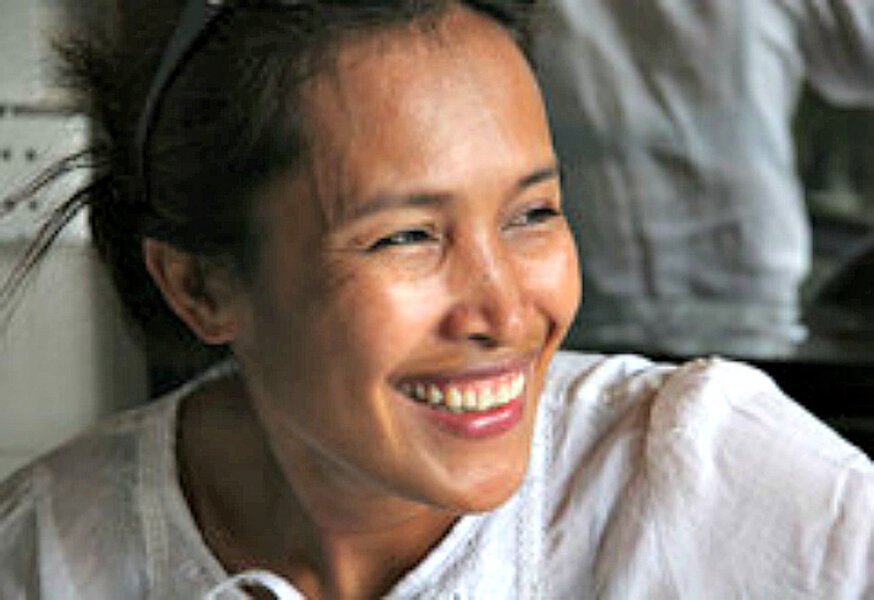How to end modern slavery
Loading...
- Problem: There are an estimated 21 million people enslaved today, 4.5 million of which are in the sex industry.
- Barrier to Progress: Global human trafficking is the second-largest and fastest-growing organized crime in the world. There are many root causes and serious challenges, including oppressive cultural norms, gender inequality, poverty, and too few resources.
- Solution: Modern slavery is a global problem but it is solvable. Solutions include education, skills training, and social enterprise projects. Focusing efforts in these areas can help create next-generation change and a society that says no more to this heinous crime.
As a survivor of sex slavery, I have dedicated my life’s work to ending it.
To many people, the issue of slavery seems like a clear case of right and wrong. The reality is much more complicated. There are many root causes and serious challenges. But these challenges do not stop me from continuing to find solutions to eradicate slavery and empower its survivors as part of the solution.
A significant number of people believe that slavery ended in 1863 when, in fact, modern slavery exists in every corner of the globe. Not just in remote parts of Southeast Asia, but in your hometown, in your backyard. In America, there are 60,000 men, women, and children enslaved at this very moment.
Global human trafficking is the second-largest and fastest-growing organized crime in the world. There are an estimated 21 million people enslaved today, 4.5 million of which are in the sex industry. Estimates for revenues in all forms of exploitation and slavery total upwards of $32 billion a year, and profits from sex slavery amount to nearly $10 billion.
In June 2013, the US State Department issued the most up to date Trafficking in Persons report, a global overview of the origins and scope of trafficking. In my country of Cambodia, a country that is still recovering from the trauma of the Khmer Rouge genocide, the trafficking of women and girls continues to be widespread. Due to multiple factors, including poverty, corruption, gender inequality, and oppressive cultural norms, Cambodia has yet to tackle this problem head on. In 2013, Cambodia fell to the Tier 2 watch list, the report’s second-lowest rank, for failing to “demonstrate evidence of overall increasing efforts to address human trafficking over the previous year.”
The subordination of Cambodian women is not only the result of too few resources or a broken civil society, but also of belief systems handed down from generation to generation. Even today, women and girls are often taught to be subordinate, lack access to education, and are more likely to suffer from the effects of poverty. Many Cambodian males perpetuate domestic violence as their primary tactic for conflict resolution, and crime as their primary source of income.
This must end. My goal is to help to empower these women and girls, to provide them with solutions, to give them a voice and a choice in their lives—and to ultimately end slavery and exploitation. Some of these solutions include, education, skills training, and social enterprise through partnerships.
On Oct. 11, the International Day of the Girl, we proudly celebrated the opening of the Somaly Mam Beauty Salon, a social enterprise developed in partnership with The Estée Lauder Companies and our on-the-ground partner AFESIP Cambodia, to implement a suite of education and training courses for survivors.
Since 1996, AFESIP Cambodia, an organization that I co-founded, has combated sexual slavery by rescuing victims of trafficking and sexual exploitation and providing recovery and skills training to help foster economic empowerment. AFESIP’s Center for Recovery and Skills Training in Siem Reap, Cambodia, offers a beauty-training and small business management program to equip survivors with the education that can boost their position in the community, remove stigmas, and encourage gender equality.
Based on AFESIP’s model, the Somaly Mam Beauty Salon provides survivors with courses in hair styling, makeup application, and nail care, as well as training in customer service and small business management. This basic education and vocational training can enable survivors to generate enough income to support themselves and avoid the vulnerabilities that allow for exploitation and abuse in the sex trade. The Estée Lauder Companies will fund the salon’s first three years of operations, with the goal of being financially self-sustaining by 2016 and creating a replicable model.
In September at the Clinton Global Initiative (CGI) meeting, the Somaly Mam Foundation pledged our commitment to action through the salon project, in partnership with The Estée Lauder Companies. Investing in women’s employment through skills training and entrepreneurship is crucial to encouraging women to take their place as empowered agents of change in Cambodia’s rapidly growing economy.
We also recently partnered with the Nike Foundation on the GIRL DECLARATION, a call to action to put girls at the heart of the post-2015 international development agenda. Along with 61 other individuals and organizations, the Somaly Mam Foundation was one of the founding signatories to this commitment to end global poverty. This declaration was presented to the United Nations on the behalf of girls worldwide.
For many years, these kinds of partnerships were my dream, and now they are a reality. Projects developed in collaboration with dedicated corporate and nonprofit partners give me hope for the future, where we can create impactful next-generation change and a society that says no more to the oppression of women and girls.
• Somaly Mam is president and co-founder of the Somaly Mam Foundation.
• This article originally appeared at the Skoll World Forum on Social Entrepreneurship, the premier international platform for accelerating entrepreneurial approaches and innovative solutions to the world’s most pressing social issues.
[Editor's note Dec. 9, 2013: An article questioning aspects of Ms. Mam's personal story and her organization was published in the Sydney Morning Herald here.]





